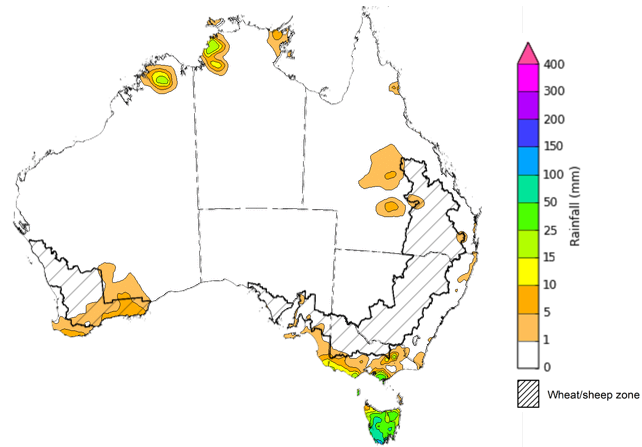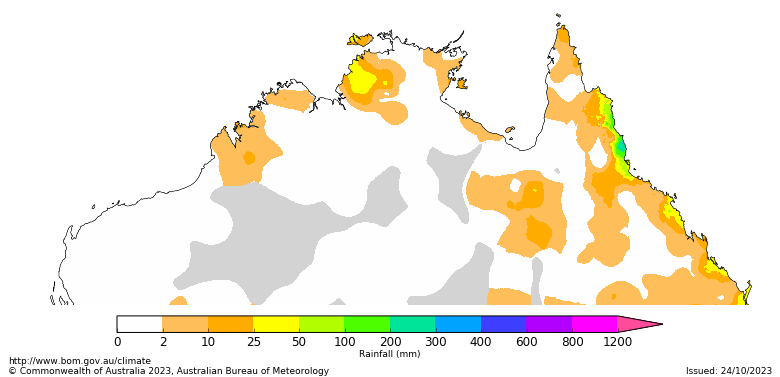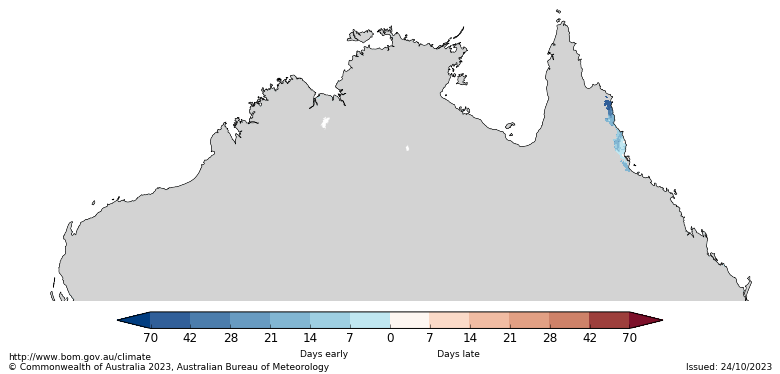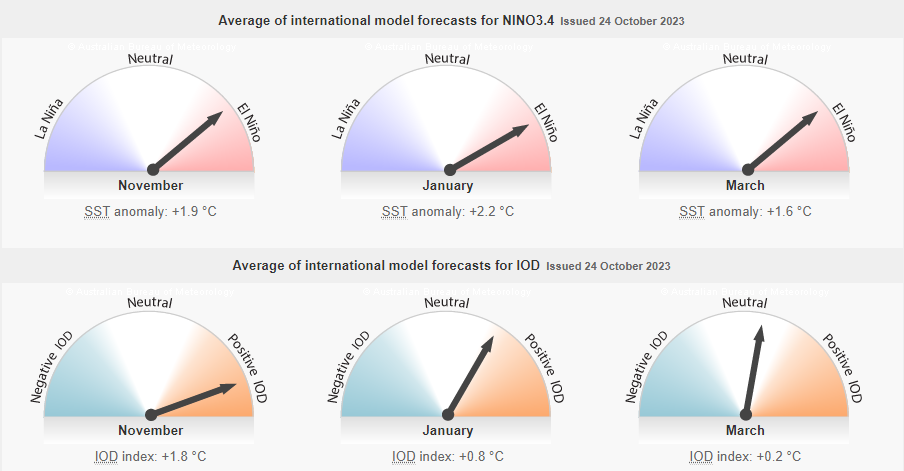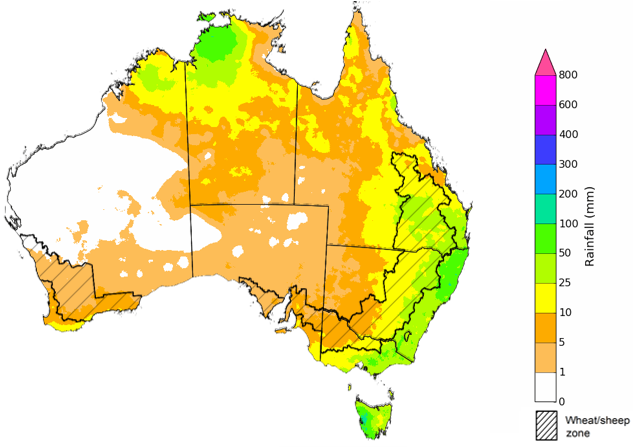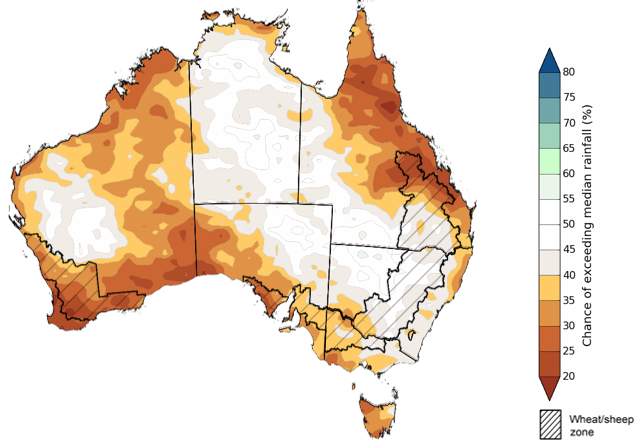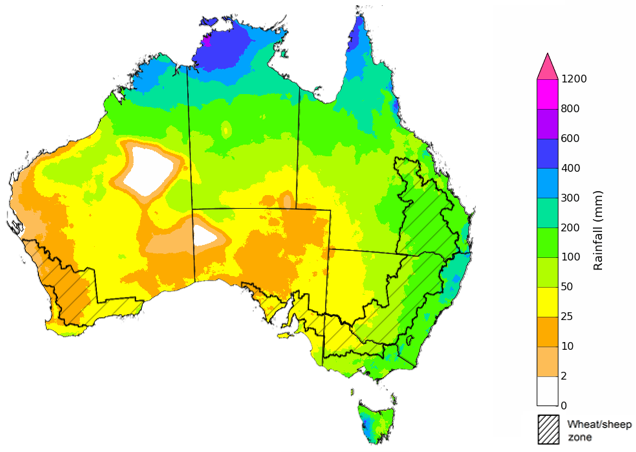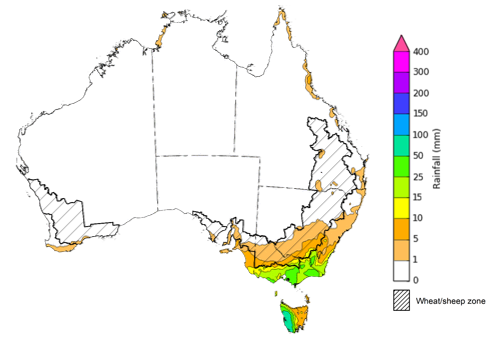Key issues
- For the week ending 25 October 2023, a high-pressure system brought mainly dry conditions to much of mainland Australia.
- Across cropping regions, rainfall totals of up to 10 millimetres were recorded in southern parts of Western Australia, with little to no rainfall recorded across remaining cropping areas.
- The dry condition across most cropping regions across northern New South Wales, Queensland and Western Australia would have allowed for the uninterrupted harvest of early planted crops.
- The northern Australia rainfall onset is yet to occur across much of tropical northern Australia.
- Over the next 8 days to 2 November 2023, dry conditions are expected across much of the country.
- A front and a low are likely to bring cooler conditions to southern Australia, but only parts of the eastern coastline, southern Victoria and Tasmania will benefit from any useful rainfall.
- An El Niño and a positive IOD event are currently underway. Their typical effect of reduced spring rainfall is currently being observed.
- Drier than normal conditions are expected in November for large areas of Australia. This represents a significant downside production risk for dry land summer crop production as well as pasture growth.
- Between November 2023 to January 2024, there is a close to equal chances of above or below median rainfall for large areas of eastern, western and central Australia, while below median rainfall is more likely for the remainder of the country.
- If these falls are realised, it is likely to be sufficient to support late spring and summer pasture growth across eastern and northern Australia. While the dry start to spring has limited early planting of dry land summer crops, the expected rainfall may be sufficient to allow for later plantings.
- Water storage levels in the Murray-Darling Basin (MDB) decreased between 19 October 2023 and 26 October 2023 by 45 gigalitres (GL). Current volume of water held in storage is 20 675 GL. This is 8 percent or 1830 GL less than at the same time last year.
- Allocation prices in the Victorian Murray below the Barmah Choke decreased from $181 on 19 October 2023 to $174 on 26 October 2023. Prices are lower in the Goulburn-Broken and regions above the Barmah choke due to the binding of the Goulburn intervalley trade limit and Barmah choke trade constraint.
Climate
For the week ending 25 October 2023, a high-pressure system brought mainly dry conditions to much of mainland Australia. A storm associated with a low-pressure system resulted in heavy rainfall and windy conditions in Tasmania.
Across cropping regions, rainfall totals of up to 10 millimetres were recorded in southern parts of Western Australia, with little to no rainfall recorded across remaining cropping areas. The dry conditions across most cropping regions would have allowed for the uninterrupted harvest of early planted winter crops but are likely to have provided little opportunity to plant dry land summer crops.
Rainfall for the week ending 25 October 2023
Issued: 25/10/2023
Note: The rainfall analyses and associated maps utilise data contained in the Bureau of Meteorology climate database, the Australian Data Archive for Meteorology (ADAM). The analyses are initially produced automatically from real-time data with limited quality control. They are intended to provide a general overview of rainfall across Australia as quickly as possible after the observations are received. For further information go to http://www.bom.gov.au/climate/rainfall/
The timing of Northern Australia rainfall onset is important indicator for seasonal pasture growth and potential livestock production. The rainfall onset gives an indication of the accumulation of at least 50 millimetres of rainfall after 1 September to stimulate plant growth after the northern dry season. Between 1 September and 24 October 2023, much of northern Australia are yet to receive at least 50 millimetres of rainfall. The only region that has recorded an early onset with at least 50 millimetres of rain is the coastal northeast Queensland.
Northern rainfall totals: 1 September to 24 October 2023
The climate drivers with the largest potential impact on Australia’s climate patterns are the El Niño–Southern Oscillation (ENSO), Madden-Julian Oscillation (MJO), Indian Ocean Dipole (IOD) and Southern Annular Mode (SAM). These climate drivers are likely to influence pasture growth across southern Australia and the growth and yield prospects for winter crops.
The SAM is currently in neutral stage and is expected to remain in the neutral stage in the coming weeks. During Spring, neutral SAM is associated with average climate conditions in southern Australia.
The MJO is currently weak and has minimal effect on northern Australia rainfall, where its effect is mainly observed.
An El Niño and a positive IOD event are currently underway. When a positive IOD and El Niño occur together, their drying effect is typically stronger and more widespread across Australia. Their effect on spring rainfall is currently being observed. The El Niño is expected to persist till at least March 2024, while positive IOD is expected to remain active till January 2024.
ENSO and IOD forecast
These climate outlooks are generated by ACCESS–S (Australian Community Climate Earth-System Simulator–Seasonal). ACCESS–S is the Bureau of Meteorology's dynamic (physics-based) weather and climate model used for monthly, seasonal, and longer-lead climate outlooks. For further information, go to http://www.bom.gov.au/climate/ahead/about/.
The Bureau of Meteorology’s latest rainfall outlook for November 2023 indicates drier than average conditions are expected across large areas of northern, western and southern Australia.
The Bureau of Meteorology’s climate model suggests that for November 2023, there is a 75% chance of rainfall totals between 10 and 100 millimetres across eastern New South Wales, southeast Queensland, and southern Victoria and northern Western Australia and Northern Territory. Rainfall totals in excess of 100 millimetres are expected across western Tasmania.
Across cropping regions, there is a 75% chance of rainfall totals of between 10 and 50 millimetres in New South Wales, Queensland, and in parts of southern Western Australia and Victoria. November rainfall totals are expected to be below 10 millimetres for the remaining cropping regions.
These relatively low expected rainfall totals continue to represent a significant downside production risk for dry land summer crop production as well as pasture growth, particularly given the lack of rainfall in recent weeks and declining soil moisture levels across large areas of the cropping regions.
Rainfall totals that have a 75% chance of occurring in November 2023
The rainfall outlook for November 2023 to January 2024 suggests that there is close to equal chances of above or below median rainfall for large areas of eastern, western and central Australia, while below median rainfall is more likely for the remainder of the country.
Across cropping regions, below median rainfall is more likely northern Queensland and close to equal chances of above or below median rainfall is likely in the remaining cropping areas.
Chance of exceeding the median rainfall November 2023 to January 2024
The outlook for November 2023 to January 2024 suggests there is a 75% chance of rainfall totals between 25 and 200 millimetres across much of Australia. The main exceptions are in large areas of South Australia and western and central parts of Western Australia where below 25 millimetres of rainfall are expected, and in areas of across tropical northern Australia, coastal New South Wales and western Tasmania, where rainfall totals in excess of 200 millimetres are expected.
In cropping regions, there is a 75% chance of receiving between 50 and 200 millimetres across New South Wales, Queensland and eastern Victoria while less than 50 millimetres of rainfall are likely across remaining cropping regions.
If these falls are realised, it is likely to be sufficient to support late spring and summer pasture growth across eastern and northern Australia. Additional while the dry start to spring has limited early planting of summer crops these falls may be sufficient to allow for later summer crop planting.
Rainfall totals that have a 75% chance of occurring November 2023 to January 2024
Over the 8 days to 2 November 2023, dry conditions are expected across much of the country. A trough in the east will bring gusty winds and showers to parts of north-eastern New South Wales and southeast Queensland. A trough and cold front will bring showers and some storms to Tasmania and parts of southern Victoria.
Across cropping regions, rainfall totals up to 15 millimetres are forecast for far eastern margins of New South Wales and Queensland, while little to no rainfall is expected elsewhere. The dry expected condition across most cropping regions will allow for the uninterrupted harvest of early planted winter crops. However, these dry conditions are expected to result in further delays to the timely planting of dry land summer crops.
Total forecast rainfall for the period 26 October 2023 to 2 November 2023
Issued 25/10/2023
Note: This rainfall forecast is produced from computer models. As the model outputs are not altered by weather forecasters, it is important to check local forecasts and warnings issued by the Bureau of Meteorology.
Water
Water storages, water markets and water allocations - current week
The Tableau dashboard may not meet accessibility requirements. For information about the contents of these dashboards contact ABARES.
Commodities
Information on weekly price changes in agricultural commodities is now available at the Weekly commodity price update.

